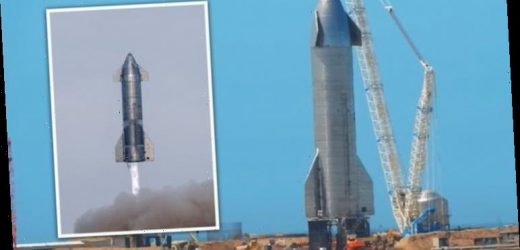SpaceX: Starship SN10 successfully lands in Texas
When you subscribe we will use the information you provide to send you these newsletters.Sometimes they’ll include recommendations for other related newsletters or services we offer.Our Privacy Notice explains more about how we use your data, and your rights.You can unsubscribe at any time.
The SpaceX rocket was moved to the launch pad on Monday where it appears to have completed its first pre-flight test. Reports from SpaceX’s secretive facility at Boca Chica, South Texas, suggest the SN11 was pumped full of nitrogen early today (March 10) to test the 164ft-tall spacecraft for leaks. SpaceX will next want to perform a cryogenic proof test of the rocket that could one day fly humans to Mars.
During a cryogenic test, the rocket is pressurised with liquid nitrogen to simulate flight conditions.
According to Michael Baylor, a spaceflight photographer and NASASpaceFlight producer, there is a chance the test could go ahead today.
Mr Baylor tweeted: “Road is open. The ambient proof was completed tonight.
“If it was successful, likely a cryogenic proof test tomorrow (March 10). Window is from noon to 8pm local time.”
Road closures around the Boca Chica facility suggest SpaceX is in for a busy week of testing.
Cameron County Judge Eddie Trevino Jr has scheduled closures from Wednesday through to Friday.
The first closures are in effect from 5pm to 1am GMT (12pm to 8pm CST) on Wednesday and Thursday.
On Friday, the closures are scheduled from 12pm to 5pm GMT (7am to 12pm).
Judge Trevino said: “Should SpaceX not complete its planned non-flight testing on March 10, 2021, then SpaceX may use the alternate dates to complete its testing activities.”
With the cryogenic test out of the way, SpaceX will need to test SN11’s three Raptor engines as the final hurdle before launch.
These so-called static fire tests will see the rocket briefly fire its engines at full thrust while staying tethered to the ground.
Static fire tests have proven a bit of a challenge with the last two Starship iterations, SN9 and SN10.
The former was left in need of an engine replacement after completing three static fire tests in a single day.
DON’T MISS…
NASA Mars mission: Perseverance rover begins first movements [REPORT]
Alien world discovered: Nearby ‘super Earth’ could be ‘Rosetta Stone’ [STUDY]
EU’s Galileo blow: OneWeb could launch ‘more effectively’ from UK [INSIGHT]
Elon Musk discusses future of SpaceX's Starship system
A similar problem then struck the SN10 a month later.
SpaceX fans now have high hopes for the SN11, hoping it will be the first Starship prototype to ace its first launch and landing.
Starship SN10 came close after flying to an altitude of 32,000ft (10km) but stumbled at the last hurdle.
Although the rocket did touch down in once piece, it was a hard landing that ended in the SN10 exploding eight minutes after landing.
According to SpaceX chief Elon Musk, 49, the landing crushed the rocket’s landing legs.
The hit likely caused a methane leak which ignited on the launch pad and blew the rocket to smithereens.
Mr Musk tweeted: “SN10 engine was low on thrust due (probably) to partial helium ingestion from fuel header tank.
“Impact of 10m/s crushed legs and part of skirt.”
However, he added multiple fixes are in the works for SN11.
Source: Read Full Article






